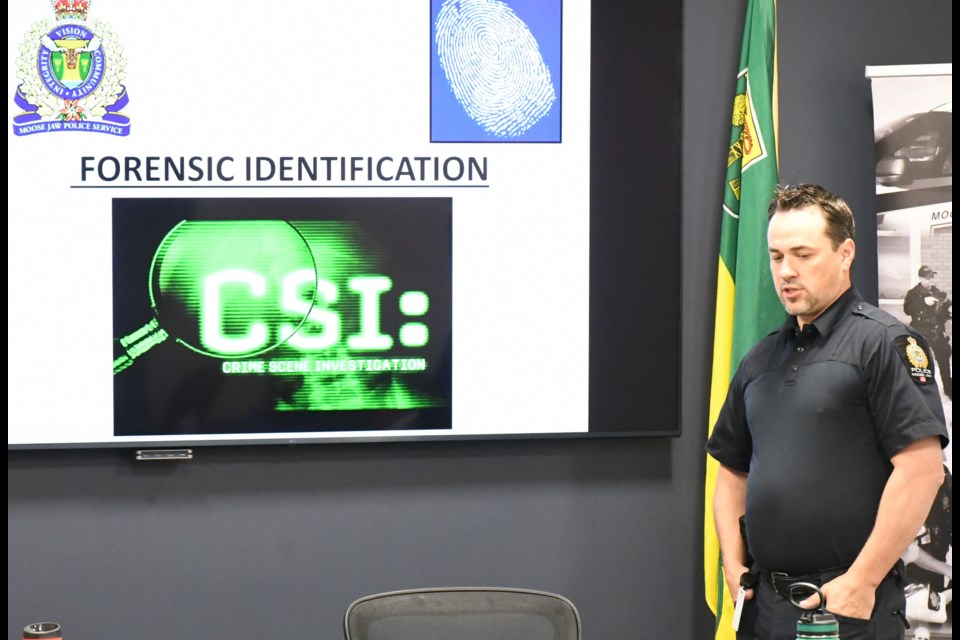MOOSE JAW — Analyzing DNA from crime scenes and identifying a criminal usually takes an hour on TV shows, but in reality, it may take almost a year for investigators to make a positive match.
Moose Jaw’s Board of Police Commissioners recently learned what goes into such investigations as Cst. Evan Schwabe spoke about his work with the Moose Jaw Police Service’s (MJPS) Forensic Identification Unit (FIU).
The Forensic Identification Unit is a behind-the-scenes group that attends to serious calls such as murders, homicides, sexual assaults and collisions, while because of the work it does, “we are the CSI guys,” Schwabe said, noting Cst. Murray Rice is the other FIU member.
Those investigative TV shows are accurate and true to a degree, although they resolve cases “a lot quicker,” the constable chuckled.
Learning the trade
Officers take a 38-day intensive course at the Canadian Police College in Ottawa, Schwabe explained, and while there are courses about forensic pathology that deal with autopsies, teeth and bones, Schwabe’s training focused on identifying and comparing fingerprints using scientific principles.
FIU members use certain chemicals — like crazy glue — and/or powders to develop and/or enhance fingerprints based on the surface while they photograph crime scenes and major collisions and accidents and digitally process images using image enhancement software, he continued.
Also, officers learn to locate, recover and preserve evidence like DNA, determine whether bloodstain patterns are evidence, properly record a scene through video or plan drawings and explore various sciences and their applicability to forensic identification.
“In the final exam, if you fail to identify a fingerprint or you get one wrong, you automatically fail the course, so there’s a little bit of stress and pressure that way,” Schwabe added.
Analyzing fingerprints
If Schwabe discovers a fingerprint at a crime scene, he must find another expert — usually Rice — to confirm whether it was a specific person. Meanwhile, he must take good photos at scenes — even in the dark — because they are used in court during trials.
Neither the Crown nor defence has ever questioned the science behind the fingerprint process, he noted.
Meanwhile, Schwabe analyzes stolen vehicles regularly to determine who stole them, with his efforts on one SUV producing three fingerprints on the rear passenger door.
One way FIU members identify an alleged offender is through “friction ridge identification,” which is established through the agreement of friction ridge formations — bumps — on a finger.
“They all have different variations. And each one of your eight fingers and two thumbs is different from everyone else in the world,” said Schwabe. “They’ve never found the two same fingerprints.”
Help from Ottawa
If members don’t have a suspect, they turn to a national online database that contains every fingerprint of anyone who has ever been arrested. That gives the FIU ideas on who the person might be.
“… I have yet to see them be wrong,” Schwabe said, noting the database helped police arrest an Albertan who robbed a truck in Moose Jaw while passing through.
There is also a national database containing the DNA of certain criminals, so FIU members look for bodily substances at scenes or collect them from alleged offenders and compare those substances with what Ottawa has.
DNA and privacy
The MJPS does not use online platforms like Ancestry.ca for general DNA investigations because that invades people’s privacy, said Schwabe. However, for serious incidents like murder, the FIU would consider using that website to identify suspects through other family members.
There are national forensic identification labs in Edmonton, Ottawa and Surrey, British Columbia that analyze firearms/ballistics, DNA, and a mix of both, respectively, with Edmonton taking 240 days to analyze an object and Ottawa taking 65 days, he continued.
However, because those labs are so busy, they are giving work to a lab in Quebec.
“You could be waiting a while for these results, but in my experience, it’s worth it and they usually get the results we’re looking for,” said Schwabe. “It could be sometimes up to a year; it’s not like the TV shows.”
Other evidence
Officers also look for other pieces of evidence at crime scenes, such as footprints. Schwabe recalled investigating a break-in at the Cosmo Seniors Centre and coming across a shoeprint that was caked with drywall dust.
“It was one of our regular customers. And we arrested him a day later and he was wearing the same shoes … ,” the constable said.
FIU members also look for tire impressions, with Schwabe recalling how officers arrested a man who was regularly sexually assaulting women using tire imprints where the incidents occurred.
An “unfortunate” part of the job is dealing with sudden deaths like suicides or homicides, so FIU members regularly work with the coroner’s office. Schwabe noted that members must wear hazardous materials suits to enter homes to take fingerprints because some people have been dead for days.




